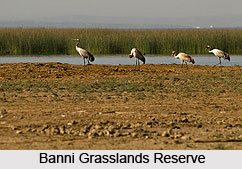 Reserved forests in India are rich sources of the diverse wildlife of the country. Reserved forests in India enjoy considerably a higher degree of security as compared to the protected forests of the country. It is because of the reason that reserved forests in India do not permit grazing or hunting in its confines while protected forests allow with some degree of constraints. The term reserved forest was first introduced in the Indian Forest Act, 1927, to refer to those forests granted defence by the government in British India. However, even after the independence of the country, the Government of India held the status of reserved forests as well as integrating new reserved forests. Thus, a large number of forests that came under the jurisdiction of the Indian Government during the political integration of the country were primarily granted such defence. All reserve forests in India, be it the mountainous terrain of the Gulmarg Biosphere Reserve or be it the green plains of Nandan Kanan Reserve Forest, are infused with the sense of adventure.
Reserved forests in India are rich sources of the diverse wildlife of the country. Reserved forests in India enjoy considerably a higher degree of security as compared to the protected forests of the country. It is because of the reason that reserved forests in India do not permit grazing or hunting in its confines while protected forests allow with some degree of constraints. The term reserved forest was first introduced in the Indian Forest Act, 1927, to refer to those forests granted defence by the government in British India. However, even after the independence of the country, the Government of India held the status of reserved forests as well as integrating new reserved forests. Thus, a large number of forests that came under the jurisdiction of the Indian Government during the political integration of the country were primarily granted such defence. All reserve forests in India, be it the mountainous terrain of the Gulmarg Biosphere Reserve or be it the green plains of Nandan Kanan Reserve Forest, are infused with the sense of adventure.Features of Reserved Forests in India
Unlike the national parks or the wildlife sanctuaries of the country, the reserved forests as well as the protected forests in India are declared by respective state governments. However, protected forests and reserved forests differ significantly. Protected forests are basically of two types namely demarcated protected forests and un-demarcated protected forests. In reserved forests the rights to activities such as hunting and grazing are not allowed. The reserved forests carry a living indication to helping hands that have been forwarded by Indian environmentalists and keen animal lovers. Reserved forests in India are often raised to the status of wildlife sanctuaries, which in turn may be upgraded to the position of national parks. Like for instance, Sariska National Park was announced a reserved forest of India in the year 1955, later upgraded to the position of wildlife sanctuary in the year 1958, and eventually becoming a tiger reserve in the year 1978. It became a national park in the year 1992.
 Bhavnagar Amreli Forest
Bhavnagar Amreli ForestBhavnagar Amreli Forest, situated in the Amreli district of Gujarat, is an Indian reserve forest famed for conserving Asiatic lions. Being the pride of Gujarat, the lions of the state were shifted to this forest on the instructions of the Central Government.
Banni Grasslands Reserve
Banni Grasslands Reserve is a part of the arid grassland ecosystem on the southern edge of the desert of the marshy salt flats of Rann of Kutch in Gujarat. Spanning over an area of 3847 square kilometres, the forest is popular owing to its rich biodiversity of flora and fauna. According to the Wildlife Institute of India, it is enlisted amongst the last remaining habitats of the Cheetah in India. The land of the forest has been formed by the deposition of sediments by the Indus and other rivers over a period of about thousand years.
For more, visit the link below: